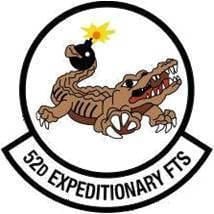Country United States Garrison/HQ Speicher Air Base | Type Pilot Training | |
 | ||
Active 1 February 1940 - 20 May 1946
1 July 1972 - 30 September 1977
11 May 1990 - 1 April 1997
29 March 2007 - Present Branch United States Air Force Part of 321st Air Expeditionary Training Group | ||
The 52d Expeditionary Flying Training Squadron (52 EFTS) is part of the Iraq Training and Advisory Mission - Air Force (ITAM-AF) and is based at Contingency Operating Base (COB) Speicher, Tikrit, Iraq. It operates T-6A aircraft conducting flight training for members of the Iraqi Air Force. C-172 and C-208 aircraft will be moved from Kirkuk Air Base to COB Speicher in spring 2010 to be incorporated in the flying training program.
Contents
Mission
Train, educate and advise professional Iraqi Airmen in order to build the institutional capacity to conduct credible fixed and rotary wing flight training for the Iraqi Air Force.
History
Activated in early 1940 as part of the pre-World War II buildup of the United States Army Air Corps after the breakout of war in Europe. Assigned to the GHQ Northeast Air District, equipped with B-18 Bolos; later early model B-17C/D heavy bombers. After the Pearl Harbor Attack. flew antisubmarine patrol missions in the Caribbean from, January–June 1942.
Returned to the United States in June 1942 and was assigned to II Bomber Command. Was an Operational Training (OTU) and later Replacement Training Unit (RTU) for B-17 heavy bomber units and replacement personnel until March 1944 with the end of Heavy Bomber training.
B-29 Superfortress operations against Japan
Re-designated on 1 April 1944 as a B-29 Superfortress Very Heavy bombardment squadron. When training was completed moved to North Field Guam in the Mariana Islands of the Central Pacific Area in January 1945 and assigned to XXI Bomber Command, Twentieth Air Force. Its mission was the strategic bombardment of the Japanese Home Islands and the destruction of its war-making capability.
Flew "shakedown" missions against Japanese targets on Moen Island, Truk, and other points in the Carolines and Marianas. The squadron began combat missions over Japan on 25 February 1945 with a firebombing mission over Northeast Tokyo. The squadron continued to participate in wide area firebombing attack, but the first ten-day blitz resulting in the Army Air Forces running out of incendiary bombs. Until then the squadron flew conventional strategic bombing missions using high explosive bombs.
The squadron continued attacking urban areas with incendiary raids until the end of the war in August 1945, attacking major Japanese cities, causing massive destruction of urbanized areas. Also conducted raids against strategic objectives, bombing aircraft factories, chemical plants, oil refineries, and other targets in Japan. The squadron flew its last combat missions on 14 August when hostilities ended. Afterwards, its B 29s carried relief supplies to Allied prisoner of war camps in Japan and Manchuria
Squadron remained in Western Pacific, although largely demobilized in the fall of 1945. Some aircraft scrapped on Tinian; others flown to storage depots in the United States. Remained as a paper unit assigned to Twentieth Air Force until inactivated in 1946.
Undergraduate Pilot Training
It conducted undergraduate pilot training from, 1972–1977 and 1990-1997. The 52d was reactivated in March 2007 as the first ever US Air Force expeditionary flying training squadron and the first flying training squadron activated in a combat zone. Its mission is to train, educate and advice Iraqi airmen to conduct undergraduate and instructor pilot training for the Iraqi Air Force.
